Low-code development platforms are becoming a new trend in the IT sector. Individual business owners and companies now recognize the benefits of using low code development for various projects.
According to Fortune Business Insights, the value of the global low code development platform may grow from $13.89 billion in 2021 to $94.75 billion by 2028.
The approach is best suited for companies that work around confidential information and cannot trust outside developers for their projects. The solution for them then lies in creating their own apps using minimal functionalities. This is where low-code platforms come into the picture. They don’t just decrease the time duration of the app development process but also make it easy for everyone to develop them.
What is Low-Code Application Development?
Low-code development is an approach that involves drag-and-drop functionality with pre-written code and automation to create apps. It’s a simplified visual approach that automates every development process to help everyone develop software and apps without coding skills.
Traditional programming languages are complex programming languages, not everyone can understand and use them without months or years of learning and practice. Low-code removes this obstacle by providing a platform where anyone can develop their own app without knowing a single thing about coding.
The approach replaces coding/full-stack development with visual drag and drop of UI components while automating the processes for frontend and backend code.
What is Low Code App Development Platforms?
Low-code platforms are typically a drag-and-drop interface that people use to build software. Many non-tech entrepreneurs find it easy to use such a platform instead of getting expensive professional developers onboard, as it saves them the six months time that developers would take for building the app from scratch.
A survey by Mendix reports that 72% of low code users developed applications within 2 to 3 months. These platforms simplify the designing of user interfaces and configuration for many non-developers and developers that need to save time. It also helps businesses accomplish IT goals without hiring the services of professional app developers.
Some common low-code platforms are Mendix, Visual Lansa, Appian, OutSystems, Zoho Creator, and Kissflow.
Low-Code App Development Features
Low code development has multiple features that can automate many complex app development solutions. These features can simplify processes that otherwise would take months and advanced coding to complete.
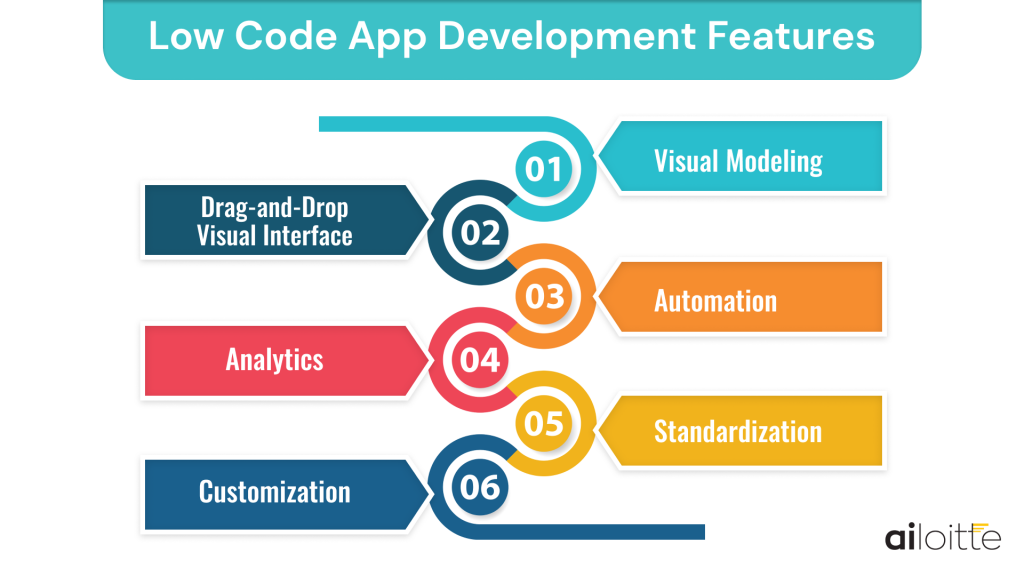
Visual Modeling
Visual modeling presents every step visually in a way that everyone with non-technical and technical background can understand. The graphic interface is easier to work with than complex lines of code and programming.
Creating applications with easy-to-use visual templates and guides acts as a catalyst for faster project delivery.
Drag-and-Drop Visual Interface
Low-code development platforms have a drag-and-drop visual interface that helps users develop an app with the same ease as children coloring already made drawings with the colors they like.
Typing long and complex lines of code is a task that requires focus, experience, and a flexible deadline. The drag-and-drop interface makes it easy to develop any software and app within or before the deadline.
Automation
Automation is one of the primary features of low code application development. It supports drag-and-drop usage to provide users with the expected final results.
A low-code platform is basically one well-designed automated process of app development. Think of it like a restaurant chef that cooks a particular dish exactly how you want it. And all you have to do is tell the chef how you like it without explaining the steps. Low code automation works the same way in app development.
Analytics
Well-designed low-code platforms also provide support to analytics, dashboard, and BI apps. Such facilities provide valuable intelligence and data writebacks. Users can get alerts, study the data, and take action quickly.
Standardization
Many top-tier low code platforms have strict in-built standardization protocols. Non-developers and even developers find it a hassle to work on software that abides by different standards. So when low-code platforms offer the feature, it regulates development by setting predetermined processes for the project. Additionally, it helps multiple users work on the same project since all of them have to conform to the same standards.
Customization
Customization is an important feature to have in low-code development platforms. Non-developers can use various customization features to modify application templates, HTML, or graphical user interface editors.
Benefits of Low Code Development
Low code development makes the complex process of software development efficient and easy to speed up. This development approach is also beneficial for the overall budget compared to traditional development.
Here are some well-known advantages of low code software development to keep in mind:
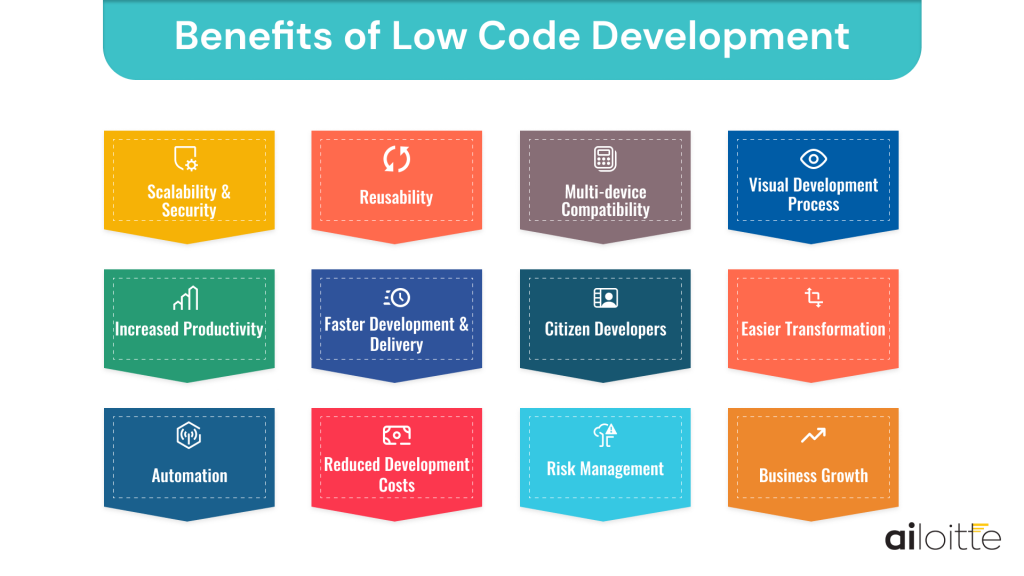
Scalability & Security
The scalability of low-code platforms is a significant factor to consider in app development. You may need to add new users to the app when your company decides to expand. Low code platforms have enough scalability to meet those requirements.
The right low-code platforms provide a top-tier and secure experience for the platform and projects.
Reusability
The primary functions of low code feature-set like modules, drag-and-drop tools, and templates are in-built and ready to use for as many projects as required. It makes low-code development the most efficiently reusable app development platform.
Multi-device Compatibility
An app with multi-device compatibility is essential to meet the requirements of a global customer base and low-code development includes multi-device compatibility for all its projects. Businesses can reach all of their target audience, irrespective of which device they are on, by using low code to deploy the product.
Visual Development Process
Low code involves functions that provide a visual interface to show what you are developing as you develop it. The traditional process involves a lot of code writing and hours of typing. Visual drag-and-drop proves helpful for non-developers compared to that. They know exactly how it will turn out at the end of the development cycle.
Increased Productivity
Companies usually rely on experienced developers to deliver on the app requirements. It takes too much time with feedback, delays, and change implementations. Low code software development solves this problem by putting the development project in the hands of the business owner. Knowing they have total control over the development process increases productivity and accelerates project delivery while meeting all the requirements.
Faster Development & Delivery
Low-code development includes a simple drag-and-drop visual interface that anyone can use to develop software and apps. It leads to an accelerated development process and final product delivery.
Some business projects have a tight deadline for almost every software development project, for which low code development proves to be immensely beneficial.
Citizen Developers
Not everyone can develop apps with traditional development and complex coding. Low code development is creating a way for everyone to become the developers of their app projects. Any individual with zero experience in app development can use low code to develop such programs with no real difficulties.
Certain citizens may not have developer experience but have the business knowledge to know the exact requirements of an app. Such business owners can quickly turn that knowledge into reality due to the ease of low code development. That is how the approach is creating more citizen developers every day.
Easier Transformation
It is easier for companies to adapt to new business trends and requirements with low code. Businesses often have to transform their digital services through new apps to meet the changing needs. It can take time to accomplish that with traditional development.
Low code speeds up that development process and helps businesses keep up with new trends and requirements. It is one of the most important low code advantages to keep in mind.
Automation
Some of the best low-code platforms have in-built automation technology. The platforms integrate automation with their various functionalities. API accessibility and in-built automation make it easy to develop any app program without any coding skill at all. A low code tool with a good automation program can be as easy to use as the copy-paste feature.
Reduced Development Costs
Traditional app developers are expensive and finding the best team can be a time-consuming process. The only way to find fairly-priced development services is by outsourcing to offshore developers. But that may also not be a viable option for every business.
Low code mobile app development costs are inexpensive compared to traditional development. It saves the company time and money on experienced developers and complex coding tools.
Risk Management
Low-code development platforms have data security standards that can manage or prevent the risks associated with data management. They reduce inconsequential data or implement security protocols to protect data from theft and leaks.
The security protocols the platform comes with make it the perfect choice for businesses with confidential data, multiple app requirements, and tight deadlines.
Business Growth
With low code development companies save money on development and speed up the project delivery. The correct use of such a platform can lead to business growth and benefits for many companies. For example, a food delivery company can use low code to build one delivery app for customers and one for delivery executives in the same timeframe and with minimum costs.
The same company can customize the apps to meet different requirements of the target audience from various locations.
Applications of Low Code App Development
Low code development has multiple applications in the IT sector. But building apps with no developer background is the primary use of this approach.
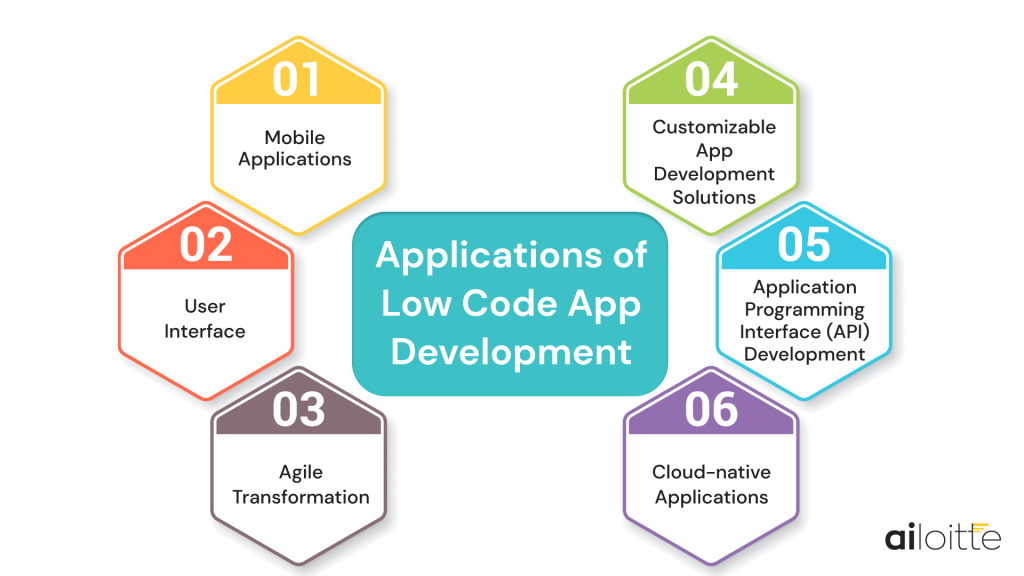
Mobile Applications
Creating a mobile app for either Android or iOS takes months and costs money. Traditional coding is also extremely complicated to understand without months/years of learning and practice. And that is when low code mobile app development makes all the difference.
Low code development comes with affordable costs and a short development duration. The best part of using such platforms is the simple drag-and-drop functionality in a graphical user interface, with which business owners or individuals can develop a mobile app with no coding experience.
User Interface
UI design is one of the complex tasks for developers to accomplish next to ensuring its compatibility on multiple platforms/devices. Designing an appealing user interface usually takes professional developers. But low code web app development also makes it easy for non-developers to create a user interface.
The customization plus drag and drop approach simplifies the complex process for users and can guarantee similar results as you get with traditional coding.
Agile Transformation
Agile transformation is a process that reinvents the whole business into a form that conforms to the agile approach. Low code app development also speeds up the transformation process that otherwise takes time. It is essential to achieve the goal of a business with Agile transformation.
Customizable App Development Solutions
Customized app development requires a big budget, experienced developers, and flexible deadlines. A company rarely has all these things together at once. Low code web app development removes the need for such spending.
Many recognized low code development tools provide the same customizable solutions with drag-and-drop functionality. Individuals can customize the solutions during development and after completion with such low code platforms.
Application Programming Interface (API) Development
Application Programming Interface (API) is a software programming code interface that creates a connection between applications to facilitate information exchange. It takes about a month or two to build a good API.
Low code app builder platforms provide pre-designed templates to create the same APIs in a short time.
Cloud-native Applications
Developing a cloud-native application requires collaborative hand coding and complex microservices. Low code removes the need for such hand coding and simplifies microservices to promote the accelerated development of cloud-native applications.
Disadvantages of Low Code Development
Low code development does not have many downsides, but you should know its few cons to understand whether it is beneficial or disadvantageous for your requirements.
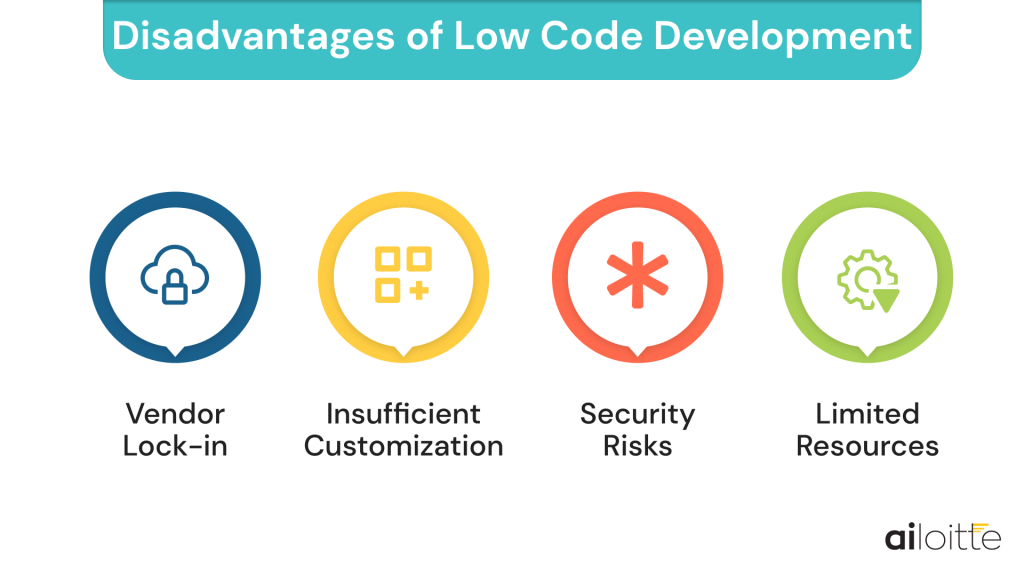
Vendor Lock-in
You choose the low code platform as you would an app development company.
The major con in this choice is that your dependability on the low code/no code platform increases with every project. It will eventually lead to low code/no code becoming an integral part of the company base your business stands on. And it may become financially or strategically impractical to use any other platform than LCNC platforms.
Such dependability on a single vendor is never good for any business.
Insufficient Customization
Low-code development platforms have customization tools to meet the requirements of multiple projects but these customization tools are not always enough for every app development project. A business may have to alter the scope of its requirements to use low code in such cases or even choose the traditional development methods to meet the complex requirements which low-code won’t be able to help with.
Security Risks
Low-code platforms offer a secure place to develop apps with reliable data protection. But such security is not in the hands of the party that builds the program. It is in the hands of the platform owner. This can lead to problems like hacking, data leak, or theft of confidential data if the low code platform owner is not reliable or trustworthy.
Limited Resources
Low code development may accelerate the development process and help non-developers create complex apps with ease. However, they have a limit that you cannot go beyond when it comes to development.
Every low-code functionality like drag-and-drop, UI interface templates, and automation comes with limitations. The platform owner may update such functionality to do more and provide more. But you will always have a limit you cannot cross when working on the app project. This will be problematic for many complex app development projects.
Traditional coding will be the best option for such requirements as it does not put such limits on the process.
The 9 Principles of Low-Code Development
The principles of low code determine the standards the platforms must follow to ensure the convenience it promises to users.
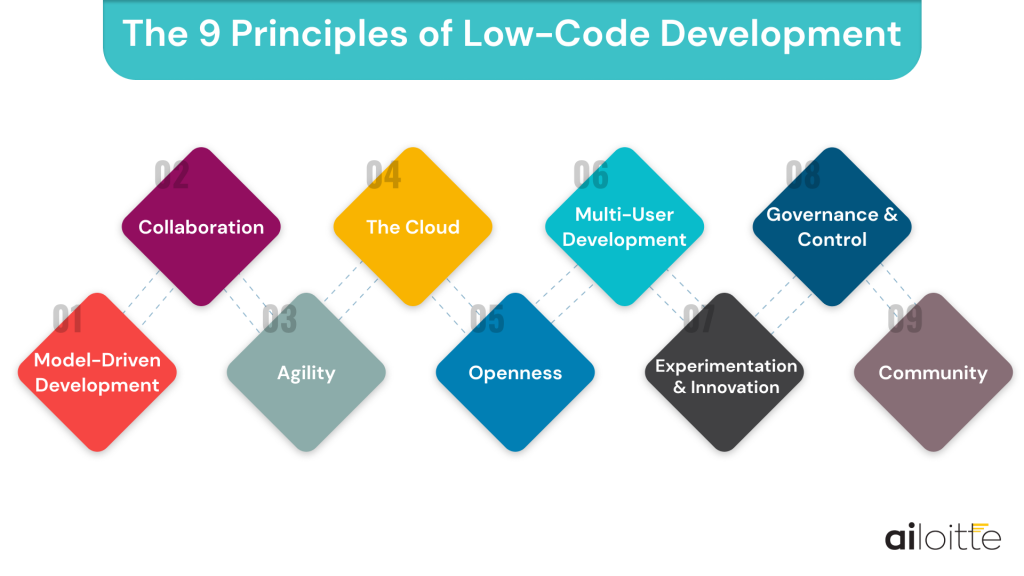
Model-Driven Development
The low-code platforms must provide business value to users with automation, flexibility, customization, and data security.
Collaboration
The platform must create a visual language that business owners and developers can use to improve collaboration through information exchanges.
Agility
The low-code platforms should reduce the development complexity to improve efficiency, accelerate final delivery, and provide business results of value.
The Cloud
The cloud must simplify development and accelerate project deployment to meet customer demand.
Openness
The platform must enable the creation of multiple categories of software. It must become an all-in-one solution for quick and better app development.
Multi-User Development
The platform must provide multi-user compatibility and project synchronization for various projects. The developers can work on the same project at the same time due to this.
Experimentation & Innovation
The low-code development platform services must have a fair price range to ensure many individuals and business owners can turn their ideas into reality.
The fair pricing will help developers experiment with the project and produce final results that represent the best of innovation.
Governance & Control
The platform must have reliable protocols and standards to ensure a secure experience for every user. The owner must take control in case of any suspicious activity before it turns into a major security problem.
Community
The platform must enable the creation of a community to promote its authenticity and reliability.
How to Choose a Low-code Platform?
Choosing the low code platform that meets every requirement of your app development project can be difficult. Keep certain things in mind when browsing through various low code/no code platforms.
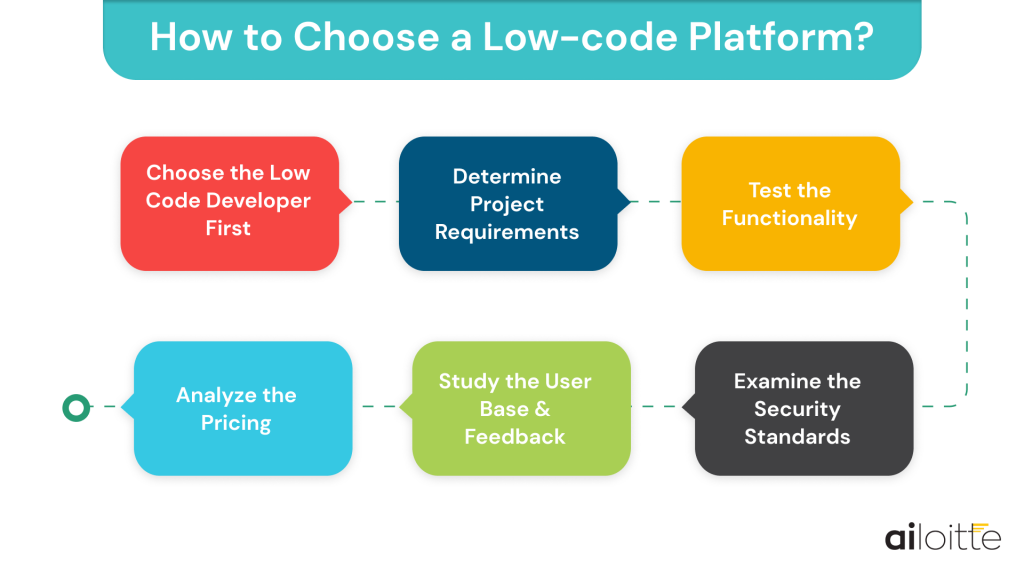
Choose the Low Code Developer First
You must determine the low code developers that will build your app on the platform – whether it is going to be you or someone else. It is because low-code platforms require some basic coding skills to use and no code platforms with simple drag-and-drop visual interfaces require none.
The person you choose for the design, development, and maintenance will help you determine whether you need a low-code platform (requires basic coding skills) or no coding platform (suitable for citizen developers).
Determine Project Requirements
The functionalities and services of various low-code platforms can differ from each other. You must determine your requirements without leaving out even the minute detail.
Ask questions like:
- Does the platform have an in-built program that enables multi-device compatibility for apps?
- Can the platform develop user-centric iOS or Android apps?
- Does the low code platform have in-built automated development technology?
- Does the low-code platform have enough functionalities for a complex app?
- Is the platform integrated with the cloud for better deployment?
- Which and how many apps has the platform helped create?
It will help you choose the platform designed to meet the needs of your app development project.
Test the Functionality
You must carefully assess how quickly the platform can develop an app. Examine the functionality of every feature the platform provides. It will help you understand how it will work for your project.
Examine the Security Standards
You have to know every security standard the platform has for data protection. It will help you understand whether you can trust the platform with confidential project data or not. You must ensure that the low code platform you choose conforms to every standard required. Moreover, figure out whether the platform enables the creation of apps that need to comply with HIPAA and GDPR compliance.
Study the User Base & Feedback
You should study the current user base of the low code/no code platform. Find out their opinion on the same platform and whether they recommend it to others. It will help you understand the low-code platform you are choosing for your project better.
Analyze the Pricing
One of the important reasons for choosing a low code platform is affordable pricing. You can compare the pricing of the low-code platform with the costs of traditional development for your project. It will reveal whether the platform is financially beneficial for your project or not.
Conclusion
Removing the need for advanced coding skills will make low code development the first choice of many citizen developers. There are many ways low-code is better than traditional coding. And some projects require a traditional coding approach to ensure expected results. Noting that low code/no code has found a distinctive role in the IT sector. Turning app development into a process as easy as categorizing folders has helped business owners give life to their creative imaginations.
However, if you are a business owner that cannot afford to expose an app to risks associated with low code like unreliable security and vendor lock-in, you will be better off with an offshore mobile app development company like Ailotte. We provide traditional app development solutions that come with affordable rates and a guarantee that the developed app will meet all your business and market expectations, something you can rarely expect from low code.
Frequently Asked Questions
Low code development requires the most basic coding knowledge to develop an app with a platform where you use drag-and-drop functionality for app development.
No code development is another term for low code where you need no coding knowledge to develop a software or app. You can use the graphical user interface with drag-and-drop functionality to finish the entire project.
Some top low-code development platforms are Visual LANSA, Zoho Creator, Mendix, and Appian.
The primary benefits of low code in app development are:
Scalability & Security
Reusability
Multi-device Compatibility
Visual Development Process
Increased Productivity
Faster Development & Delivery
Easier Agile Transformation
Reduced Development Costs
Low code development platforms have a limit with all their services and functionality. Some of them are not flexible enough and some lack customization features. They are suitable for standard software and app development but apps with highly complex requirements can lead to a failure with low code. They are better off with traditional coding and development.
Choosing an unsuitable low code platform for your project requirement will also lead to failure.
Low code development is the best option if your app development project has a tight budget, deadline, and standard requirements.


















.png)
.png)
.png)



Leave a Comment